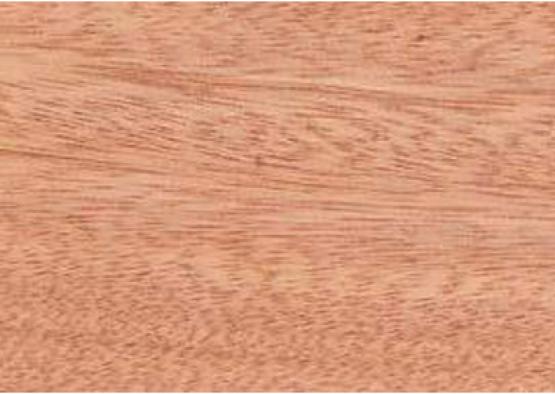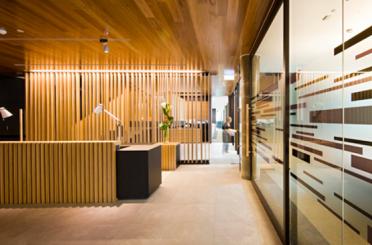Philippine light red mahogany is a tropical hardwood sought after as a finishing timber throughout Australia.
Almon, Mayapis, White Lauan, Bagtikan, White Seraya, Gerutu, Thingado, Meranti, Putih, Parashorea Spp, Parashorea malaanonan, Shorea almon, Shorea squamata, Palosapis, Parashorea plicata, Pentacme contorta, Pacific Maple
Shorea Spp

Philippine light red mahogany is a tropical hardwood typically found in Malaysia, Indonesia and the Philippines. Part of the extensive Shorea species that includes over 180 species, it is a popular export timber and widely used as a slightly cheaper alternative to teak. The light red of the species is the most common and is sought after as a finishing timber throughout Australia.
The heartwood of light red mahogany is a pale straw colour when first cut, with a characteristic oily odour. It turns to a pale pink to mid red brown hue as it dries. The sapwood is up to 50mm wide and usually yellow, pink, or grey and sometimes not easily distinguished. The timber's texture is coarse but even, with an interlocked grain that often produces a stripe or ribbon figure on the radial surface. Logs may contain brittleheart. Narrow concentric lines of resin ducts may be mistaken for growth rings and pinhole borer discolouration and pencil streak is more common than in dark red mahogany.
The timber is relatively easy to dry but bluestain can be a problem unless precautions are taken. It mostly finishes well, although tools must be kept sharp to avoid producing a woolly surface. This feature can often be overcome with sanding. Light red mahogany nails and glues well but beware of localised tearing when cross cutting and pre-drilling. It is unsuitable for steam bending.
Philippine light red mahogany is often used for plywood, internal moulding, joinery and paneling. It is popular for domestic finishing applications such as skirting boards, architraves and door jambs.
Shrinkage
| Very Low | Low | Medium | High | Very High | |
|---|---|---|---|---|---|

|

|

|
|||
Tangential : |
4.20%
|
||||
Radial : |
1.60%
|
||||
Unit Movement Tangential: |
0.30%
|
||||
Unit Movement Radial: |
0.14%
|
Strength Group

Very High |
High |
Reasonably High |
Medium High |
Medium |
Reasonably Low |
Low |
Very Low |
||
Unseasoned: |
S1 |
S2 |
S3 |
S4 |
S5 |
S6 |
S7 |
S8 |
|
|---|---|---|---|---|---|---|---|---|---|
 |
|||||||||
Seasoned: |
SD1 |
SD2 |
SD3 |
SD4 |
SD5 |
SD6 |
SD7 |
SD8 |
|
 |
Stress Grade

| Structural No. 1 |
Structural No. 2 |
Structural No. 3 |
Structural No. 4 |
Structural No. 5 |
|
Unseasoned: |
F8 |
F7 |
F5 |
F4 |
|
Seasoned: |
F11 |
F8 |
F7 |
F5 |
F4 |
Density per Standard

Seasoned: |
550kg/m3
|
|---|---|
Unseasoned: |
Joint Group

Very High |
High |
Reasonably High |
Medium |
Low |
Very Low |
|
Unseasoned: |
J1 |
J2 |
J3 |
J4 |
J5 |
J6 |
|---|---|---|---|---|---|---|
Seasoned: |
JD1 |
JD2 |
JD3 |
JD4 |
JD5 |
JD6 |
 |
Colour

| White, yellow, pale straw to light brown | Pink to pink brown | Light to dark red | Brown, chocolate, mottled or streaky | |
 |
||||
Mechanical Properties
Modulus of Rupture - Unseasoned: |
46
|
|---|---|
Modulus of Rupture - Seasoned: |
66
|
Modulus of Elasticity - Unseasoned: |
7.2
|
Modulus of Elasticity - Seasoned: |
8.5
|
Maximum Crushing Strength - Unseasoned:  |
23
|
Maximum Crushing Strength - Seasoned: |
41
|
Impact - Unseasoned: |
|
Impact - Seasoned: |
|
Toughness - Unseasoned: |
|
Toughness - Seasoned: |
|
Hardness - Unseasoned: |
2
|
Hardness - Seasoned: |
2
|
Durability
| Low | Moderate | Reasonably High | High | |
| (0 - 5 yrs) | (5 - 15 yrs) | (15 - 25 yrs) | (more than 25 yrs) | |
In-Ground: |
 |
|||
| (0 - 7 yrs) | (7 - 15 yrs) | (15 - 40 yrs) | (More than 40 yrs) | |
Above ground: |
 |
|||
| (0 - 20 yrs, usually < 5) | (21 - 40 yrs) | (41 - 64 yrs) | (More than 60 yrs) | |
Marine Borer Resistance: |
 |
Lyctid Borer Susceptibility: |
Susceptible |
|---|---|
Lyctid Borer Susceptibility - Other: |
|
Termite Resistance: |
Not Resistant
|
Fire Properties
| 0 | 1 | 2 | 3 | 4 | 5 | 6 | 7 | 8 | 9 | 10 | |
EFH Spread-of-Flame Index: |
|||||||||||
EFH Smoke-Developed Index: |
| 1 - non-combustible | 2 - reasonably non-combustible | 3 - slightly combustible | 4 - combustible | |
Fire Properties Group |
Group Number - Other: |
3 if used on MDF or particleboard ≥12mm; veneer thickness 0.6-0.85mm
|
|---|---|
Average Specific Extinction Area: |
<250
|
Bushfire Resistance: |
Not Tested
|
The heartwood of light red mahogany is a pale straw colour when first cut, with a characteristic oily odour. It turns to a pale pink to mid red brown hue as it dries. The sapwood is up to 50mm wide and usually yellow, pink, or grey and easily distinguished. The timber's texture is coarse but even, with an interlocked grain that often produces a stripe or ribbon figure on the radial surface. Narrow concentric lines of resin ducts may be mistaken for growth rings and pinhole borer discolouration and pencil streak is more common than in dark red mahogany.
Philippine light red mahogany is often used for plywood, internal moulding, joinery and paneling. It is popular for domestic finishing applications such as skirting boards, architraves and door jambs.
The timber is relatively easy to dry but bluestain can be a problem unless precautions are taken. It mostly finishes well, although tools must be kept sharp to avoid producing a woolly surface. This feature can often be overcome with sanding. Light red mahogany nails and glues well but beware of localised tearing when cross cutting and pre-drilling. It is unsuitable for steam bending.

